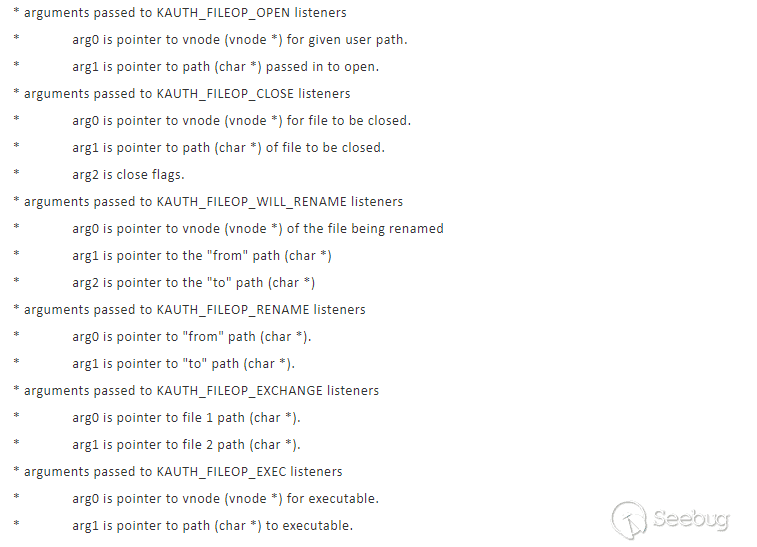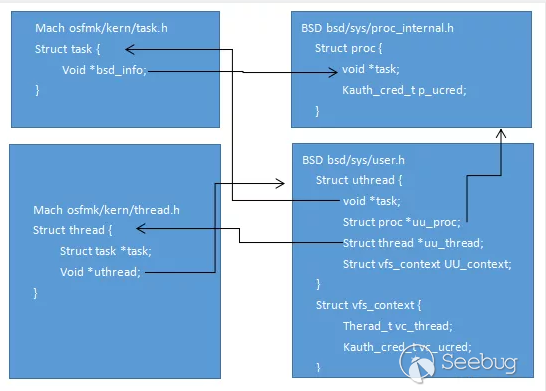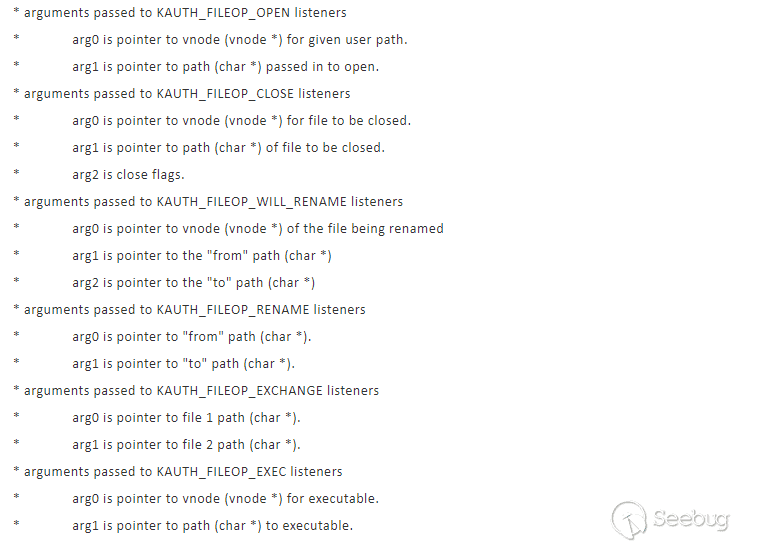
作者:wzt
原文链接:https://mp.weixin.qq.com/s/Tm4z-_po6DmurcneKQ536A
1.1 简介
XNU将进程凭证credential、文件系统acl授权、进程和文件系统监控这几个安全功能抽象为一个安全框架,叫做kauth子系统。它的具体功能主要包含:
- 进程凭证credential的创建、更新、销毁。
- 文件系统acl的创建、评估、销毁。
- 提供kauth scope框架,对进程、文件系统做监控, 支持系统默认监控函数,提供kpi接口,使得第三方内核扩展可以动态添加钩子。
1.2 进程凭证维护
1.2.1 基本结构
XNU与传统UNIX的进程凭证cred稍有不同。
bsd/sys/ucred.h:
struct ucred {
TAILQ_ENTRY(ucred) cr_link; /* never modify this without KAUTH_CRED_HASH_LOCK */
u_long cr_ref; /* reference count */
struct posix_cred {
uid_t cr_uid; /* effective user id */
uid_t cr_ruid; /* real user id */
uid_t cr_svuid; /* saved user id */
short cr_ngroups; /* number of groups in advisory list */
gid_t cr_groups[NGROUPS]; /* advisory group list */
gid_t cr_rgid; /* real group id */
gid_t cr_svgid; /* saved group id */
uid_t cr_gmuid; /* UID for group membership purposes */
int cr_flags; /* flags on credential */
} cr_posix;
struct label *cr_label; /* MAC label */
struct au_session cr_audit; /* user auditing data */
};
struct ucred基本继承了BSD的ucred结构,保留了MAC label和audit审计成员,因为xnu内核完全继承了BSD的MAC和audit子系统能力。同时去掉了poison成员, xnu没有使用bsd jail的功能,对于xnu的沙箱功能,在后面的系列文章中在详细介绍。xnu ucred仍然包含用户所在的组概念,成员cr_groups数组长度为16,是unix家族中标准的用户组大小。除了cr_groups,xnu使用kauth子系统扩展了用户所在组的概念,cr_groups包含的仅是本地机器的用户组,Mac OS可以作为服务器使用,kauth建立了一种额外的扩展能力,可以将网络上的其他机器用户组包含到本地组里。
XNU是一个混合的内核,mach微内核部分控制内核的进程创建与调度功能, mach的进程结构体包含了指向bsd进程和线程结构体的指针,而cred是BSD内核的功能,自然包含在bsd封装的进程和线程结构体里,它们之间的数据结构体关系如下:

内核通过current_thread()宏来获取mach层的struct thread指针,以i386架构为例:
osfmk/i386/cpu_data.h
#define current_thread_fast() get_active_thread()
#define current_thread() current_thread_fast()
static inline __pure2 thread_t
get_active_thread(void)
{
CPU_DATA_GET(cpu_active_thread,thread_t)
}
#define CPU_DATA_GET(member,type) \
type ret; \
__asm__ volatile ("mov %%gs:%P1,%0" \
: "=r" (ret) \
: "i" (offsetof(cpu_data_t,member))); \
return ret;
typedef struct cpu_data
{
thread_t cpu_active_thread;
} cpu_data_t;
cpu_data_t结构体里的cpu_active_thread成员指向的就是当前cpu指向的mac thread指针, 通过offsetof宏计算处它的偏移,在i386下%gs:offset保存的就是它的地址。X64下保存在%fs:offset。
内核通过get_bsdthread_info函数获取mac thread指向的bsd thread指针:
osfmk/kern/bsd_kern.c
void *get_bsdthread_info(thread_t th)
{
return(th->uthread);
}
内核通过get_threadtask函数获取mac thread指向的mac task指针,然后就可以通过mac task找到bsd进程的proc指针。
osfmk/kern/bsd_kern.c
task_t get_threadtask(thread_t th)
{
return(th->task);
}
void *get_bsdtask_info(task_t t)
{
return(t->bsd_info);
}
内核通过kauth_cred_get函数获取进程的cred结构指针,根据以上结构信息也就不难理解了。
bsd/kern/kern_credential.c
kauth_cred_t
kauth_cred_get(void)
{
struct proc *p;
struct uthread *uthread;
uthread = get_bsdthread_info(current_thread());
if (uthread == NULL)
panic("thread wants credential but has no BSD thread info");
if (uthread->uu_ucred == NOCRED) {
if ((p = (proc_t) get_bsdtask_info(get_threadtask(current_thread()))) == NULL)
panic("thread wants credential but has no BSD process");
uthread->uu_ucred = kauth_cred_proc_ref(p);
}
return(uthread->uu_ucred);
}
1.2.2 cred维护
XNU对于进程cred的维护与BSD、linux有所不同, 它将每个进程的cred缓存在一个hash表里,对于复制cred等操作,可以通过引用计数来实现,在它的代码注释中提到这种优化对于一个桌面系统来讲,可以至少节省200k左右的内存。
1.2.3 组扩展机制
前面提到xnu扩展了bsd的用户组管理机制,在内核中叫做kauth resolver机制, 在kauth初始化时,建立了几个队列,当内核使用cred进行用户组授权的过程中, 将本次请求封装为一个worker,加入相应的队列中等待用户态进程进行处理。xnu增加了一个系统调用identitysvc,用户进程使用这个系统调用与kauth通讯,比如获取等待队列中的worker,然后在用户态进行处理。用户组涉及到的处理逻辑相对复杂,xnu直接引用了windows nt内核的sid概念来完善kuath授权系统。
1.2.3.1 kauth resolver机制初始化
bsd/kern/kern_authorization.c
void
kauth_init(void)
{
#if CONFIG_EXT_RESOLVER
kauth_identity_init();[1]
kauth_groups_init();[2]
#endif
#if CONFIG_EXT_RESOLVER
kauth_resolver_init();[3]
#endif
}
Kauth_init在初始时[1]处调用kauth_identity_init()初始化kauth_identities链表,每个节点是struct kauth_identity结构体,这个链表用来缓存cred的身份信息,因为如果每次身份验证时都要用户态进程参与,那么效率将会非常低,kauth在每次用户态验证完时,将验证成功的身份信息缓存在kauth_identities链表里,下次验证时将在缓存里进行搜索,如果没有匹配到,在通知用户态进程处理。[2]处的kauth_groups_init()函数功能机理与上述一致。[3]处的kauth_resolver_init函数初始化了三个队列,分别为kauth_resolver_unsubmitted、kauth_resolver_submitted、kauth_resolver_done。
1.2.3.2 identitysvc系统调用
用户态进程通过调用identitysvc系统调用在内核中进行注册,更新缓存大小、获取处理任务以及发送任务的处理结果。
先来看下用户进程的注册过程。
bsd/kern/kern_credential.c
int
identitysvc(__unused struct proc *p, struct identitysvc_args *uap, __unused int32_t *retval)
{
if (opcode == KAUTH_EXTLOOKUP_REGISTER) {
new_id = current_proc()->p_pid;
if ((error = kauth_authorize_generic(kauth_cred_get(), KAUTH_GENERIC_ISSUSER)) != 0) { [1]
KAUTH_DEBUG("RESOLVER - pid %d refused permission to become identity resolver", new_id);
return(error);
}
if (kauth_resolver_identity != new_id) {[2]
kauth_resolver_identity = new_id;[3]
kauth_resolver_registered = 1;
wakeup(&kauth_resolver_unsubmitted);[4]
}
当来自用户空间的请求码为KAUTH_EXTLOOKUP_REGISTER时, 在[1]处调用 kauth_authorize_generic, 这是后面将要讲到的kauth scope监控机制,当前内核的默认授权只是检测当前进程uid是不是为0, 也就是说只有root权限用户才可以注册。[2]处判断当前进程和之前注册的进程号是否相同,如果不相同就会用当前进程号替换原来的进程号kauth_resolver_identity,然后在[4]处唤醒kauth_resolver_unsubmitted等待队列上的进程。
我们看到用户进程的注册过程相当简单,这里就会有几个安全问题。所有root进程都可以进行注册,linux使用了capability进一步将root权限进行了划分, 比如auditd的注册就需要有CAP_NET_ADMIN这个能力才可以。而XNU并没有继承BSD的capability能力模型以及privilege特权模型,这使得它对内核权限的控制就没有那么细致化。其次新的用户进程直接就可以替换老的用户进程,并没有使用一些可信验证手段, 这使得任何的恶意root进程都可以对其进行替换和仿冒,这样身份验证机制就形同虚设了。
我们在来看下用户进程是如何从内核获取任务的。
bsd/kern/kern_credential.c
int
identitysvc(__unused struct proc *p, struct identitysvc_args *uap, __unused int32_t *retval)
{
if (opcode & KAUTH_EXTLOOKUP_WORKER) {
if ((error = kauth_resolver_getwork(message)) != 0)
return(error);
}
}
static int
kauth_resolver_getwork(user_addr_t message)
{
struct kauth_resolver_work *workp;
while ((workp = TAILQ_FIRST(&kauth_resolver_unsubmitted)) == NULL) {
thread_t thread = current_thread();
struct uthread *ut = get_bsdthread_info(thread);
ut->uu_save.uus_kauth.message = message;
error = msleep0(&kauth_resolver_unsubmitted, kauth_resolver_mtx, PCATCH, "GRGetWork", 0, kauth_resolver_getwork_continue);
KAUTH_RESOLVER_UNLOCK();
if (!kauth_resolver_identity) {
printf("external resolver died");
error = KAUTH_RESOLVER_FAILED_ERRCODE;
}
return(error);
}
return kauth_resolver_getwork2(message);
}
kauth_resolver_getwork函数用户获取内核任务, 首先判断kauth_resolver_unsubmitted队列是否为空,这个队列保存的是内核发布的等待用户进程获取的任务节点,下一小节会对其进行描述。如果队列为空,就使用msleep进行睡眠,同时回调函数设置为kauth_resolver_getwork_continue,这个函数只是继续判断队列是否为空,然后递归调用自己。当队列不为空时,会调用kauth_resolver_getwork2。它从kauth_resolver_unsubmitted队列头取下一个节点,用copyout函数拷贝给用户空间的进程,然后将这个节点移入到kauth_resolver_submitted队列,这样用户进程就获取了要进行身份验证的信息。
当用户进程处理完毕后,处理结果要返回给内核。
bsd/kern/kern_credential.c
int
identitysvc(__unused struct proc *p, struct identitysvc_args *uap, __unused int32_t *retval)
{
if (opcode & KAUTH_EXTLOOKUP_RESULT) {
if ((error = kauth_resolver_complete(message)) != 0)
return(error);
}
}
static int
kauth_resolver_complete(user_addr_t message)
{
if ((error = copyin(message, &extl, sizeof(extl))) != 0) {
KAUTH_DEBUG("RESOLVER - error getting completed work\n");
return(error);
}
if (extl.el_result != KAUTH_EXTLOOKUP_FATAL) {
TAILQ_FOREACH(workp, &kauth_resolver_submitted, kr_link) {
if (workp->kr_seqno == extl.el_seqno) {
TAILQ_INSERT_TAIL(&kauth_resolver_done, workp, kr_link);
}
kauth_resolver_complete通过copyin将用户信息拷贝到内核,然后遍历kauth_resolver_submitted队列,根据seq号找到对应的节点,更新处理信息,然后将这个节点移动到kauth_resolver_done队列。
1.2.3.3 cred身份验证
当涉及到cred的身份验证时,kauth调用kauth_cred_cache_lookup函数进行处理。
bsd/kern/kern_credential.c
static int
kauth_cred_cache_lookup(int from, int to, void *src, void *dst)
{
switch(from) {
case KI_VALID_UID:[1]
error = kauth_identity_find_uid(*(uid_t *)src, &ki, namebuf);
if (expired) {
if (!expired(&ki)) {[2]
KAUTH_DEBUG("CACHE - entry valid, unexpired");
error = kauth_resolver_submit(&el, extend_data);[3]
if (error == 0) {
kauth_identity_updatecache(&el, &ki, extend_data);[4]
}
kauth在kauth_identities cache中维护着一个转换列表,cred中的uid可以对应kauth_identities中的guid、ntsid等等。比如转换类型为KI_VALID_UID,则在[1]处调用kauth_identity_find_uid,在cache中进行搜索。找到后,还要在[2]处进行验证身份信息是否过
static int
kauth_resolver_submit(struct kauth_identity_extlookup *lkp, uint64_t extend_data)
{
struct kauth_resolver_work *workp, *killp;
MALLOC(workp, struct kauth_resolver_work *, sizeof(*workp), M_KAUTH, M_WAITOK); [1]
if (workp == NULL)
return(ENOMEM);
workp->kr_work = *lkp;
workp->kr_extend = extend_data;
workp->kr_refs = 1;
workp->kr_flags = KAUTH_REQUEST_UNSUBMITTED;
workp->kr_result = 0;
KAUTH_RESOLVER_LOCK();
workp->kr_seqno = workp->kr_work.el_seqno = kauth_resolver_sequence++;
workp->kr_work.el_result = KAUTH_EXTLOOKUP_INPROG;
TAILQ_INSERT_TAIL(&kauth_resolver_unsubmitted, workp, kr_link); [2]
wakeup_one((caddr_t)&kauth_resolver_unsubmitted); [3]
error = __KERNEL_IS_WAITING_ON_EXTERNAL_CREDENTIAL_RESOLVER__(workp); [4]
if (error == 0)
*lkp = workp->kr_work; [5]
}
期。如果没找到会在[3]处调用kauth_resolver_submit, 将当前处理信息封装为一个struct kauth_identity_extlookup结构体发送到等待队列中进行处理。
[1] 处封装为一个struct kauth_resolver_work worker节点,在[2]处挂接到kauth_resolver_unsubmitted队列末尾,在[3]处唤醒在这个等待队列上睡眠的进程,通常为用户态的memberd守护进程。然后在[4]处调用 _KERNEL_IS_WAITING_ON_EXTERNAL_CREDENTIAL_RESOLVER_函数,它一直调用msleep睡眠kauth_resolver_timeout秒,再次被唤醒后,检查worker的状态是否为KAUTH_REQUEST_DONE,如果是则函数返回,否则继续睡眠重复上述行为。当worker被处理完毕后,在[5]处保存更新后的信息。这个信息是用户态进程处理完毕后使用identitysvc系统调用进行同步的。回到kauth_cred_cache_lookup函数,它将调用kauth_identity_updatecache在缓存中更新相关信息。
1.2.4 进程和文件系统监控
1.2.4.1 kauth scope框架
Kauth定义了一个scope监控框架,提供默认和第三方内核扩展回调函数支持,可以对进程和文件系统的关键行为进行监控。
监控类型有几下几种:
bsd/sys/kauth.h #define KAUTH_SCOPE_GENERIC "com.apple.kauth.generic" #define KAUTH_SCOPE_PROCESS "com.apple.kauth.process" #define KAUTH_SCOPE_VNODE "com.apple.kauth.vnode" #define KAUTH_SCOPE_FILEOP "com.apple.kauth.fileop"
KAUTH_SCOPE_GENERIC是通用的内核事件监控函数,比如在前面章节讲到的用户态进程注册kauth resovler时就调用了它的默认监控函数,只判断进程的uid号是否为0。
KAUTH_SCOPE_PROCESS提供进程事件的相关监控,目前只对能否向目标进程发送信号和是否有调试权限做了监控。
KAUTH_SCOPE_VNODE提供了对vnode的权限检查以及acl评估功能。
KAUTH_SCOPE_FILEOP提供了对文件状态和属性更改的监控,它类似于linux的fsnotify文件系统监控框架。
Kauth子系统定义了struct kauth_scope结构:
#define KAUTH_SCOPE_MAX_LISTENERS 15
struct kauth_scope {
TAILQ_ENTRY(kauth_scope) ks_link;
volatile struct kauth_local_listener ks_listeners[KAUTH_SCOPE_MAX_LISTENERS];
const char * ks_identifier;
kauth_scope_callback_t ks_callback;
void * ks_idata;
u_int ks_flags;
};
ks_callback即为默认的callback函数。ks_listeners为第三方内核扩展定义的callback函数。每个scope最多有15个扩展回调函数。
struct kauth_local_listener {
kauth_listener_t kll_listenerp;
kauth_scope_callback_t kll_callback;
void * kll_idata;
}
内核使用kauth_register_scope注册一个scope。
kauth_scope_t
kauth_register_scope(const char *identifier, kauth_scope_callback_t callback, void *idata)
{
kauth_scope_t sp, tsp;
kauth_listener_t klp;
if ((sp = kauth_alloc_scope(identifier, callback, idata)) == NULL)
return(NULL);
KAUTH_SCOPELOCK();
TAILQ_FOREACH(tsp, &kauth_scopes, ks_link) {
if (strncmp(tsp->ks_identifier, identifier,
strlen(tsp->ks_identifier) + 1) == 0) {
KAUTH_SCOPEUNLOCK();
FREE(sp, M_KAUTH);
return(NULL);
}
}
TAILQ_INSERT_TAIL(&kauth_scopes, sp, ks_link);
restart:
TAILQ_FOREACH(klp, &kauth_dangling_listeners, kl_link) {
if (strncmp(klp->kl_identifier, sp->ks_identifier,
strlen(klp->kl_identifier) + 1) == 0) {
if (kauth_add_callback_to_scope(sp, klp) == 0) {
TAILQ_REMOVE(&kauth_dangling_listeners, klp, kl_link);
}
else {
break;
}
goto restart;
}
}
KAUTH_SCOPEUNLOCK();
return(sp);
}
所有scope存在于kauth_scopes链表,kauth_register_scope首先根据名称搜索是否已经存在重名的scope节点,存在直接返回。如果不存在的话,将其挂接于kauth_scopes链表末尾。然后它遍历kauth_dangling_listeners链表,这里保存的是备用的第三方回调函数节点kauth listener, 调用kauth_add_callback_to_scope将其添加到对应的scope listener数组里。
static int kauth_add_callback_to_scope(kauth_scope_t sp, kauth_listener_t klp)
{
int i;
for (i = 0; i < KAUTH_SCOPE_MAX_LISTENERS; i++) {
if (sp->ks_listeners[i].kll_listenerp == NULL) {
sp->ks_listeners[i].kll_callback = klp->kl_callback;
sp->ks_listeners[i].kll_idata = klp->kl_idata;
sp->ks_listeners[i].kll_listenerp = klp;
sp->ks_flags |= KS_F_HAS_LISTENERS;
return(0);
}
}
return(ENOSPC);
}
内核使用kauth_listen_scope函数注册一个第三方内核扩展listener到一个scope上。
kauth_listener_t
kauth_listen_scope(const char *identifier, kauth_scope_callback_t callback, void *idata)
{
kauth_listener_t klp;
kauth_scope_t sp;
if ((klp = kauth_alloc_listener(identifier, callback, idata)) == NULL)
return(NULL);
KAUTH_SCOPELOCK();
TAILQ_FOREACH(sp, &kauth_scopes, ks_link) {
if (strncmp(sp->ks_identifier, identifier,
strlen(sp->ks_identifier) + 1) == 0) {
if (kauth_add_callback_to_scope(sp, klp) == 0) {
KAUTH_SCOPEUNLOCK();
return(klp);
}
KAUTH_SCOPEUNLOCK();
FREE(klp, M_KAUTH);
return(NULL);
}
}
TAILQ_INSERT_TAIL(&kauth_dangling_listeners, klp, kl_link);
KAUTH_SCOPEUNLOCK();
return(klp);
}
它的注册逻辑也非常简单,首先遍历kauth_scopes链表找到对应的scope,如果找到,就调用kauth_add_callback_to_scope将其加入scope的listener数组里。如果没找到,将这个节点挂接于kauth_dangling_listeners备用链表中, 当需要的scope被注册时,会自动从kauth_dangling_listeners链表中找到这个节点并挂接上去。
在需要监控的内核路径中, 会调用kauth_authorize_action函数。
int
kauth_authorize_action(kauth_scope_t scope, kauth_cred_t credential, kauth_action_t action,
uintptr_t arg0, uintptr_t arg1, uintptr_t arg2, uintptr_t arg3)
{
int result, ret, i;
if (scope->ks_callback != NULL)
result = scope->ks_callback(credential, scope->ks_idata, action, arg0, arg1,
else
result = KAUTH_RESULT_DEFER;
if ((scope->ks_flags & KS_F_HAS_LISTENERS) != 0) {
for (i = 0; i < KAUTH_SCOPE_MAX_LISTENERS; i++) {
ret = scope->ks_listeners[i].kll_callback(
credential, scope->ks_listeners[i].kll_idata,
action, arg0, arg1, arg2, arg3);
if ((ret == KAUTH_RESULT_DENY) ||
(result == KAUTH_RESULT_DEFER))
result = ret;
}
}
return(result == KAUTH_RESULT_ALLOW ? 0 : EPERM);
}
首先它会调用默认的回调函数,然后如果此scope有listener,则将依次调用listener注册的回调函数, 算法有点类似acl评估机制,如果有一个listener拒绝的话就直接返回失败。
1.2.4.2 进程监控
Kauth在初始化的时候调用kauth_scope_init初始化三个监控类型的scope。
static void
kauth_scope_init(void)
{
kauth_scope_mtx = lck_mtx_alloc_init(kauth_lck_grp, 0 /*LCK_ATTR_NULL*/);
kauth_scope_process = kauth_register_scope(KAUTH_SCOPE_PROCESS, kauth_authorize_process_callback, NULL);
kauth_scope_generic = kauth_register_scope(KAUTH_SCOPE_GENERIC, kauth_authorize_generic_callback, NULL);
kauth_scope_fileop = kauth_register_scope(KAUTH_SCOPE_FILEOP, NULL, NULL);
}
对于进程的监控,注册的默认回调函数为kauth_authorize_process_callback。
static int
kauth_authorize_process_callback(kauth_cred_t credential, __unused void *idata, kauth_action_t action,
uintptr_t arg0, uintptr_t arg1, __unused uintptr_t arg2, __unused uintptr_t arg3)
{
switch(action) {
case KAUTH_PROCESS_CANSIGNAL:
panic("KAUTH_PROCESS_CANSIGNAL not implemented");
if (cansignal(current_proc(), credential, (struct proc *)arg0, (int)arg1))
return(KAUTH_RESULT_ALLOW);
break;
case KAUTH_PROCESS_CANTRACE:
if (cantrace(current_proc(), credential, (proc_t)arg0, (int *)arg1))
return(KAUTH_RESULT_ALLOW);
break;
}
return(KAUTH_RESULT_DEFER);
}
回调函数非常简单,只判断进程是否有trace能力,对于是否能有发送信号的能力,xnu内核开发者估计也没想好,panic函数直接写在了cansignal函数的前面。
1.2.4.3 文件状态监控
在kauth_scope_init初始化时,并没有对KAUTH_SCOPE_FILEOP类型的scope设置默认回调函数。
static void
kauth_scope_init(void)
{
kauth_scope_fileop = kauth_register_scope(KAUTH_SCOPE_FILEOP, NULL, NULL);
}
在文件状态发生变更的地方,都调用了kauth_authorize_fileop函数,它继而调用kauth_authorize_action函数,由于KAUTH_SCOPE_FILEOP类型的scope没有默认回调函数,它将继续判断是否有加载第三方内核扩展的回调函数。对于文件系统状态监控,开发人员需要自己编写一个内核扩展注册listene回调函数到scope中才行,xnu内核并没有提供默认的内核扩展。
kauth_authorize_fileop函数定义为:
int
kauth_authorize_fileop(kauth_cred_t credential, kauth_action_t action, uintptr_t arg0, uintptr_t arg1);
内核在文件系统的不同路径调用它,最后两个参数在不同的调用路径对应不同的意义。内核注释代码中写的很详细:

1.2.4.4 文件vnode授权与acl检查
对于文件vnode监控的kauth scope注册是放在文件系统初始化进行的:
bsd/vfs/vfs_subr.c
void
vnode_authorize_init(void)
{
vnode_scope = kauth_register_scope(KAUTH_SCOPE_VNODE, vnode_authorize_callback, NULL);
}
它注册的callback函数为vnode_authorize_callback。vnode的权限检查包括以下几个:

为了加快检查速度,xnu使用了一个cache机制,在vnode的结构体加入了v_authorized_actions成员,它代表了上一次是做的哪项权限检查,通过调用vnode_cache_is_authorized执行vp->v_authorized_actions & action,来判断是否命中上次cache,之后在执行完权限检查后,通过调用vnode_cache_authorized_action执行vp->v_authorized_actions |= action更新cache。
Xnu将文件系统的acl评估机制也封装到了kauth子系统里。
bsd/sys/kauth.h
struct kauth_acl {
u_int32_t acl_entrycount;
u_int32_t acl_flags;
struct kauth_ace acl_ace[1];
};
acl_entrycount表示的是struct kauth_ace acl_ace数组的大小。
struct kauth_ace {
guid_t ace_applicable;
u_int32_t ace_flags;
kauth_ace_rights_t ace_rights;
};
一个acl entry定义为struct kauth_ace结构,acl评估的业界通用算法就是从前到后,依次对比每个ace项,如果权限匹配为deny,则直接返回失败,否则进行下一个ace匹配。
在函数vnode_authorize_simple里判断vnode结构的acl链表是否为空,如果不为空则调用kauth_acl_evaluate进行acl权限检查。
 本文由 Seebug Paper 发布,如需转载请注明来源。本文地址:https://paper.seebug.org/1472/
本文由 Seebug Paper 发布,如需转载请注明来源。本文地址:https://paper.seebug.org/1472/
如有侵权请联系:admin#unsafe.sh